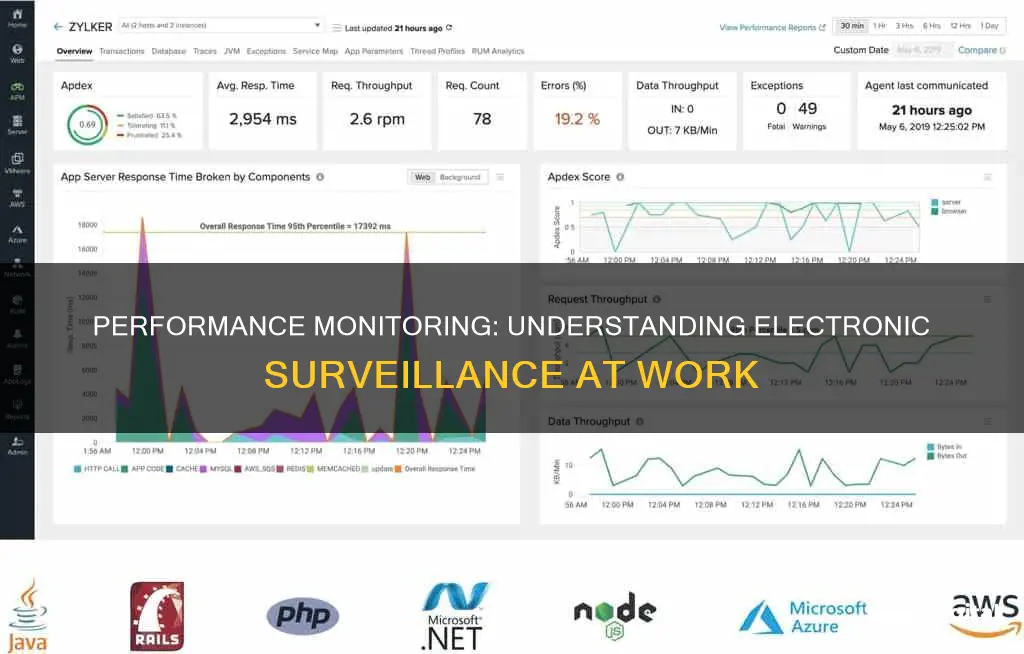
Electronic Performance Monitoring (EPM) is the use of technology to observe, record, and analyse information about an employee's work performance. The use of EPM has become increasingly common in the workplace, with the COVID-19 pandemic and the rise of remote working further increasing its prevalence.
EPM can take many forms, including:
- Computer monitoring
- Video monitoring
- Location tracking
- Biometric monitoring
- Wearable electronic safety monitors
- Email monitoring
- Phone call monitoring
- Internet usage monitoring
EPM can have both positive and negative effects on employees. Positive effects include:
- Increased productivity
- Better resource planning
- Increased worker safety
Negative effects include:
- Lower employee morale and satisfaction
- Stress
- Development of stress-related illnesses
The effects of EPM can also vary depending on its purpose, invasiveness, synchronicity, and transparency. For example, more invasive forms of EPM are associated with more negative attitudes from workers.
| Characteristics | Values |
|---|---|
| --- | --- |
| Purpose | Performance Appraisal, Loss Prevention, Profit, Development, Growth, Training, Administrative, Safety, Surveillance |
| Invasiveness | Breadth, Specificity, Target, Constraints, Control |
| Synchronicity | Synchronous, Asynchronous |
| Transparency | Transparent, Opaque |
What You'll Learn

EPM and performance
Electronic Performance Monitoring (EPM) is the use of technology to observe, record, and analyse information about employees' work performance. The COVID-19 pandemic has accelerated the adoption of EPM, with many employees now working remotely.
EPM has been found to have both positive and negative effects on performance and employee well-being.
Positive Effects of EPM on Performance and Employee Well-being
- Increased productivity: EPM can increase productivity by improving resource planning and worker safety.
- Improved performance: EPM can improve performance, especially for simple and repetitive tasks.
- Improved motivation: EPM can improve job motivation, especially when individual monitoring is applied rather than group monitoring.
- Improved job satisfaction: EPM can increase job satisfaction when employees are informed about the monitoring beforehand and when the information being recorded relates to quality aspects of their performance.
Negative Effects of EPM on Performance and Employee Well-being
- Increased stress: EPM can increase stress, especially for older individuals.
- Reduced job satisfaction: EPM can reduce job satisfaction, especially when monitoring is intensive.
- Reduced trust: EPM can reduce employee trust in the organisation, especially when monitoring is intensive.
- Reduced organisational commitment: EPM can reduce organisational commitment, especially when the extent of monitoring is high.
Factors Influencing the Effects of EPM
The effects of EPM on performance and employee well-being are influenced by a range of factors, including:
- Task difficulty: The relationship between EPM and performance is moderated by task difficulty. The relationship is positive when the task is easy and negative when the task is complex or involves creativity.
- Age: Older individuals tend to experience higher levels of stress due to EPM.
- Level of monitoring: The level of monitoring is correlated with the level of privacy invasion. Higher levels of monitoring are associated with more negative attitudes from workers.
- Invasiveness: More invasive forms of EPM (e.g. broader scope, more personal target, less target control) are associated with more negative attitudes, greater privacy invasion, and increased counterproductive work behaviours.
- Transparency: Greater transparency about EPM practices is associated with more positive performance, attitudes, and lower levels of stress/strain.
Setting Up Monitor Audio: A Beginner's Guide
You may want to see also

EPM and employee stress
The use of electronic performance monitoring (EPM) has been linked to increased stress in employees. Research has shown that the use of EPM can lead to technostress, which can result in fatigue, burnout, depression, and reduced job satisfaction.
Several factors have been found to moderate the relationship between EPM use and stress levels. For example, older individuals tend to experience higher stress levels than younger individuals when monitored. Additionally, the level of monitoring, task difficulty, and locus of control have all been found to impact stress levels.
Furthermore, the way in which EPM is implemented can also affect stress levels. Comprehensive announcements before the implementation of EPM, as well as rational explanations for monitoring, have been found to reduce stress levels. On the other hand, a high level of monitoring and the monitoring of private matters have been linked to increased stress.
Overall, while EPM can provide benefits such as increased productivity and better resource planning, it is important to carefully consider the potential negative impacts on employee stress and well-being.
Activity Monitor: Understanding Your CPU's Performance and Health
You may want to see also

EPM and employee attitudes
Electronic Performance Monitoring (EPM) is a process that uses technology to gather, store, analyse, and report employee behaviour data to assess performance and observe actions on the job. EPM can have adverse effects on employee attitudes, including job satisfaction, organisational commitment, and fairness perceptions. However, these negative consequences can be mitigated by implementing EPM with employee attitudes and privacy perceptions in mind.
Transparency
Managers should be transparent with employees about EPM use. Comprehensive announcements about EPM before implementation can positively affect job satisfaction. Being open about the types of data collected and the strategic nature of EPM can help to improve employee attitudes.
Employee reactions
It is important to be aware of all potential employee reactions to being monitored. Employees may experience negative attitudes towards the organisation if EPM is implemented inappropriately, which can lead to decreased performance and counterproductive work behaviours.
Learning and development
EPM should be used for learning and development rather than deterrence. Performance-based remuneration is a strategic part of EPM and contributes to employee retention initiatives. EPM can be used to identify development needs and provide training opportunities.
Work-related behaviours
EPM should be restricted to only work-related behaviours. This helps to maintain employee privacy and reduce the perception of privacy invasion, which can negatively impact job satisfaction.
Organisational makeup
Consider the organisational makeup when implementing an EPM system. For example, in individualistic cultures, employees may be more sensitive to privacy invasion, whereas in low power distance cultures, EPM may be rejected as it is seen as a signal of distrust.
Overall, EPM can have both positive and negative effects on employee attitudes. By following the recommendations outlined above, organisations can maximise the positive effects and minimise the negative effects of EPM on employee attitudes.
The Wide Gamut of the Asus VE245 Monitor
You may want to see also

EPM and employee privacy
The use of electronic performance monitoring (EPM) has become increasingly common in the workplace, particularly since the COVID-19 pandemic, which has led to a rise in home working. EPM can provide benefits for both employers and employees, but it also raises important privacy concerns.
EPM involves the "computerized collection, storage, analysis, and reporting of information about employees' productive activities". This can include monitoring of work behaviour, such as keystrokes and mouse clicks, as well as private matters such as location data.
Employees generally have a lower expectation of privacy when using company property, such as a laptop or smartphone. However, EPM can also be used to monitor employees' personal devices, for example, if they are working from home.
The level of privacy invasion depends on the level of monitoring. Individual monitoring typically results in a higher level of privacy invasion than monitoring at the team, department or organisational level.
Employees may feel that EPM invades their privacy, particularly if it involves monitoring of private matters. This can lead to negative attitudes towards EPM and decreased job satisfaction.
To reduce the potential negative impact on privacy, organisations should ensure that:
- Employees are informed about the monitoring and its purpose in advance.
- Monitoring policies are clear and transparent.
- Employees are involved in the development of monitoring policies.
- Employees are given control over the monitoring system, for example, the ability to turn it off.
- The organisation finds the "zone of acceptance", i.e. avoiding novel and significant changes that may concern employees.
- The organisation anchors a holistic data protection concept, including technical/organisational data protection and strategic/organisational data protection.
While EPM can provide benefits for employers and employees, it is important to carefully consider the potential impact on employee privacy. Organisations should aim to find a balance between monitoring employee performance and respecting employees' privacy rights.
Locate Network Monitor on Your MacBook Pro
You may want to see also

EPM and employee trust
The relationship between EPM and employee trust is a complex one, with several factors influencing the impact of EPM on employee trust.
The Negative Impact of EPM on Employee Trust
Studies have shown that EPM use may have a negative impact on employee trust toward the organisation. This is particularly true when employees feel that the monitoring is unjustified or that their privacy is being invaded. Employees may feel that the organisation or their supervisors do not trust them, leading to a breakdown of trust.
Factors Influencing the Impact of EPM on Employee Trust
Several factors can influence the impact of EPM on employee trust. These include:
- Comprehensive announcement: Employees may be more accepting of EPM if they are informed about it beforehand and given a clear explanation of its purpose. This can help to build trust and reduce suspicions.
- Level of monitoring: The higher the level of monitoring (individual, team, department, or organisation), the greater the potential invasion of privacy and the negative impact on employee trust.
- Type of monitoring: Monitoring of private matters, such as location tracking, is more likely to negatively impact employee trust than monitoring of work behaviour or performance.
- Employee attributes: Employee characteristics, such as age, job type, and personal need for structure, can influence their reaction to EPM. For example, older employees may feel more stressed by EPM, while employees with a higher personal need for structure may react more negatively.
- Organisational culture: The impact of EPM on employee trust can vary depending on the organisational culture. For example, in individualistic cultures, employees may be more sensitive to privacy invasion and react negatively to EPM.
- Communication and transparency: A lack of transparent communication about EPM can lead to reduced trust. Organisations should be open about the purpose of monitoring and how employee data will be used and protected.
Building Employee Trust with EPM
While EPM can potentially damage employee trust, it can also be used to build trust when implemented and communicated effectively. Organisations should aim for a "zone of acceptance" where employees understand the reasons for monitoring and do not feel that their privacy is being invaded. Involving employees in the decision-making process and giving them some control over the monitoring process can also help to build trust.
Overall, while EPM has the potential to damage employee trust, it can be implemented in a way that builds trust and improves the employee-employer relationship. Transparent communication, a clear purpose for monitoring, and respect for employee privacy are key to achieving this balance.
Fixing Monitor Dead Pixels: DIY Guide to Removal
You may want to see also
Frequently asked questions
Electronic performance monitoring (EPM) is the use of technology to observe, record, and analyse information about an employee's work performance. This can include monitoring of emails, phone calls, text messages, keystrokes, social media activity, and face-to-face interactions.
EPM can lead to higher productivity, better resource planning, and increased staff safety.
EPM can cause lower employee morale and satisfaction, as well as increased stress and stress-related illnesses. It can also lead to a relationship of distrust between the organisation and the employee.
The use of EPM has increased dramatically in recent years, with almost 80% of companies expected to be using monitoring software by 2020.
EPM raises ethical concerns around privacy and trust. It can be seen as a form of surveillance and can lead to a negative impact on employee trust towards the organisation.







